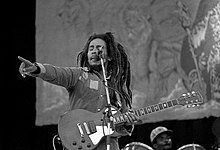Its Bob's birthday, gotta drop some shyt. 


Nesta Robert Marley OM (6 February 1945 – 11 May 1981) was a Jamaican singer-songwriter who achieved international fame through a series of crossover reggae albums. Starting out in 1963 with the group the Wailers, he forged a distinctive songwriting and vocal style that would later resonate with audiences worldwide. The Wailers would go on to release some of the earliest reggae records with producer Lee Scratch Perry. After the Wailers disbanded in 1974, Marley pursued a solo career which culminated in the release of the album Exodus in 1977 which established his worldwide reputation. He was a committed Rastafarian who infused his music with a profound sense of spirituality.
Early life and career
Nesta Robert Marley was born on the farm of his maternal grandfather in Nine Mile, Saint Ann Parish, Jamaica, to Norval Sinclair Marley and Cedella Booker. Norval Marley was a European-Jamaican of British heritage (Heather Marley once stated that he may have had distant Jewish Syrian ancestry). Norval claimed to have been a captain in the Royal Marines, though at the time of his marriage to Cedella Booker, an African-Jamaican then 18 years old, he was employed as a plantation overseer. Though Bob Marley was named Nesta Robert Marley, a Jamaican passport official would later reverse his first and middle names. Norval provided financial support for his wife and child but seldom saw them as he was often away. Bob Marley attended Stepney Primary and Junior High School which serves the catchment area of Saint Ann. In 1955, when Bob Marley was 10 years old, his father died of a heart attack at the age of 70.


Norval Marley
Marley and Neville Livingston (later known as Bunny Wailer) had been childhood friends in Nine Mile. They had started to play music together while at Stepney Primary and Junior High School. Marley left Nine Mile with his mother when he was 12 and moved to Trenchtown, Kingston. Cedella Booker and Thadeus Livingston (Bunny Wailer's father) had a daughter together whom they named Pearl, who was a younger sister to both Bob and Bunny. Now that Marley and Livingston were living together in the same house in Trenchtown, their musical explorations deepened to include the latest R&B from American radio stations whose broadcasts reached Jamaica, and the new Ska music. The move to Trenchtown was proving to be fortuitous, and Marley soon found himself in a vocal group with Bunny Livingston, Peter Tosh, Beverley Kelso and Junior Braithwaite. Joe Higgs, who was part of the successful vocal act Higgs & Wilson, resided on 3rd St., and his singing partner Roy Wilson had been raised by the grandmother of Junior Braithwaite. Higgs and Wilson would rehearse at the back of the houses between 2nd and 3rd Streets, and it wasn't long before Marley (now residing on 2nd St), Junior Braithwaite and the others were congregating around this successful duo. Marley and the others didn't play any instruments at this time, and were more interested in being a vocal harmony group. Higgs was glad to help them develop their vocal harmonies, although more importantly, he had started to teach Marley how to play guitar — thereby creating the bedrock that would later allow Marley to construct some of the biggest-selling reggae songs in the history of the genre.
Last edited:







 from that porch. Crazy how it's in one of the toughest parts of town. If you taking 295 south you can see the house from the top of that new ramp.
from that porch. Crazy how it's in one of the toughest parts of town. If you taking 295 south you can see the house from the top of that new ramp.

